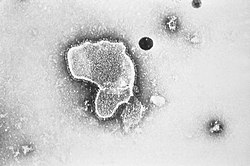Pneumoviridae
| Pneumoviridae | ||||||||||||||||
|---|---|---|---|---|---|---|---|---|---|---|---|---|---|---|---|---|
 | ||||||||||||||||
| Systematik | ||||||||||||||||
| ||||||||||||||||
| Taxonomische Merkmale | ||||||||||||||||
| ||||||||||||||||
| Wissenschaftlicher Name | ||||||||||||||||
| Pneumoviridae | ||||||||||||||||
| Links | ||||||||||||||||
|
Die Virusfamilie Pneumoviridae (früher Unterfamilie Pneumovirinae der Familie Paramyxoviridae) umfasst Viren innerhalb der Ordnung Mononegavirales (negativsträngige RNA-Viren). Sie wurden früher zur Unterfamilie Paramyxovirinae abgegrenzt, da sie trotz gemeinsamer Familienmerkmale doch in wichtigen Eigenschaften deutlich von anderen Spezies der alten Familie Paramyxoviridae verschieden sind. Diese Sonderstellung zeigt sich auch durch Sequenzvergleich der Genome mit verschiedenen Mitgliedern der Paramyxoviridae. Die darauf basierende phylogenetische Analyse führte zur Begründung als neue Virusfamilie.
Abgrenzung innerhalb der Virusfamilie
Folgende Eigenschaften der Pneumoviridae weichen von den Paramyxovirinae ab:
- kleineres Nukleokapsid (13–14 nm gegenüber 18 nm im Durchmesser) und ein zusätzliches Nukleokapsid-assoziiertes Protein M2-1[3]
- zusätzliches RNA-regulatorische Protein M2-2
- starke O-Glykosylierung des Oberflächenproteins G
- kleinere Offene Leserahmen (ORFs)
- die virale RNA-Polymerase ist in nur einem ORF kodiert und unterliegt keinem RNA-Editing
- keine notwendige durch 6 teilbare RNA-Länge wie bei den Paramyxoviridae[4]
- keine Neuraminidase- und Hämagglutinin-Aktivität der Oberflächenproteine (Ausnahme: Hüllprotein des Murinen Pneumonie-Virus)
- das Oberflächenprotein G der Pneumoviridae hat keine strukturelle Ähnlichkeit mit dem HN- und N-Protein der Paramyxovirinae. Das Glykoprotein G ist zwischen den Spezies und auch zwischen einzelnen Isolaten hoch variabel.[5]
Systematik
Mit Stand ICTV vom November 2018 gliedert sich die Familie wie folgt:
- Familie Pneumoviridae
- Gattung Orthopneumovirus (früher: Pneumovirus)[6]
- Humanes Respiratorisches Synzytial-Virus (HRSV, en. Human orthopneumovirus) (Typ A, B, …) – Atemwegsinfektion, Erkältung
- Bovines Respiratorisches Syncytialvirus (BRSV, en. Bovine orthopneumovirus) – befällt Rinder
- Murine orthopneumovirus (en. Murine orthopneumovirus) – befällt Mäuse
- Gattung Metapneumovirus[7]
- Humanes Metapneumovirus (HMPV, en. Human metapneumovirus) (Typ A1 bis 2, B1 bis 2) – Atemwegsinfektion, Erkältung, befällt auch Schimpansen und Gorillas[8][9]
- Avianes Metapneumovirus (AMPV, en. Avian metapneumovirus) – befällt Vögel
- Gattung Orthopneumovirus (früher: Pneumovirus)[6]
Einzelnachweise
- ↑ a b ICTV: ICTV Taxonomy history: Akabane orthobunyavirus, EC 51, Berlin, Germany, July 2019; Email ratification March 2020 (MSL #35)
- ↑ ICTV Master Species List 2018b v1 MSL #34, Feb. 2019
- ↑ Bhella D, Ralph A, Murphy LB, Yeo RP: Significant differences in nucleocapsid morphology within the Paramyxoviridae. Journal of General Virology (2002) 83, 8:1831-1839
- ↑ Kolakofsky D, Roux L, Garcin D, Ruigrok RW: Paramyxovirus mRNA editing, the "rule of six" and error catastrophe: a hypothesis. Journal of General Virology (2005)86,7:1869-77 (Review)
- ↑ Bastien N, Liu L, Ward D, Taylor T, Li Y: Genetic variability of the G glycoprotein gene of human metapneumovirus. Journal of Clinical Microbiology (2004) 42(8):3532-3537
- ↑ SIB: Orthopneumovirus
- ↑ SIB: Metapneumovirus, auf: ViralZone
- ↑ Nadja Podbregar: Coronavirus: Sind auch Menschenaffen gefährdet? Auf: scinexx.de vom 30. März 2020.
- ↑ Elle Hunt: Orangutans and other great apes under threat from covid-19 pandemic, auf: NewScientist vom 2. April 2020
Auf dieser Seite verwendete Medien
ID#: 2175 Description: Thic electron micrograph reveals the morphologic traits of the Respiratory Syncytial Virus (RSV). The virion is variable in shape, and size (average diameter of between 120-300nm). RSV is the most common cause of bronchiolitis and pneumonia among infants and children under 1 year of age.
Content Providers(s): CDC Creation Date: 1981
Copyright Restrictions: None - This image is in the public domain and thus free of any copyright restrictions. As a matter of courtesy we request that the content provider be credited and notified in any public or private usage of this image.